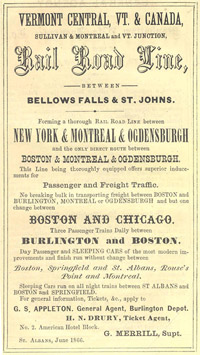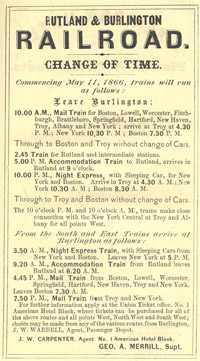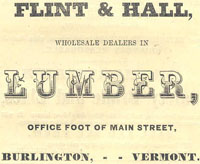

Burlington experienced continued changes from 1853 until 1869. During this time, several factors contributed to Burlington's growing lumber industry. The lumber business had slowed in about 1845, when the country became depleted of valuable timber. Ten years later, with the opening of the railroads, Burlington became the only point on Lake Champlain convenient to transport by ship or railroad (1). By 1849, the Burlington and Rutland Railroad was completed; followed shortly after by the Vermont Central line. These rail connections provided easy transport between Montreal, New York, and Boston.


The lumber business may be said to have commenced with a cargo brought to Burlington from Canada in 1850 (2), through the newly developed Chambly Canal. Entrepreneurs in the city started many wood-related industries, such as the manufacture of iceboxes, spools and bobbins, wooden boxes, and architectural products ranging from doors and windows to ornamental trim (3). From 1850 until the turn of the century lumber, many lumber companies began to spring up in Burlington, including C. Blodgett and Son, Hunterstown Lumber Co., L. Barnes and Co., and Flint & Hall,

among others. The increased production brought a need for more housing, and the city gradually began to expand eastward. The favored locations for newly prosperous, middle-class residents included Maiden Lane and North Winooski Avenue. While the working class residents inhabited the Old North End. This growth gradually moved eastward, as North Street quickly developed after the Civil War to provided housing for the laborers in the lumber industry (4). At this time Short Street (Grant between North Winooski and Maiden Lane) was extended west to Locust Street and the Vermont Central railroad ceased to run just east of Maiden Lane, allowing for the later introduction of more streets. Finally in 1865, Burlington incorporated as a city; the rural areas formed South Burlington, leaving the city of Burlington as a more urban area.
(1) Charles E. Allen, About
Burlington Vermont, (H. J. Stanley and Co., Burlington: 1905),
127.
(2) Ibid, 127.
(3) Historic Preservation Program, The Burlington Book, (Department
of History, University of Vermont, Burlington: 1980) 10-11.
(4) Ibid, 11.